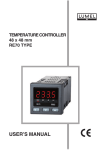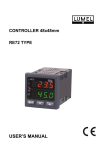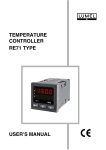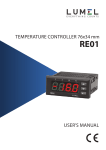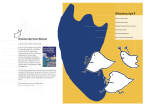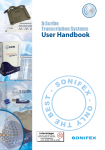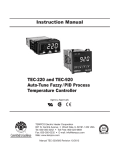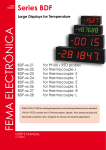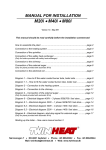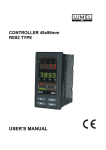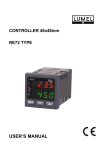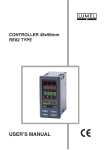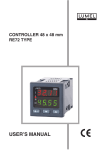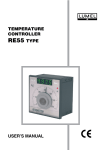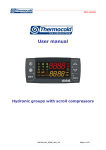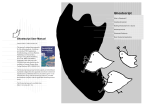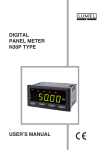Download TEMPERATURE CONTROLLER RE81 TYPE USER`S MANUAL
Transcript
TEMPERATURE CONTROLLER RE81 TYPE USER’S MANUAL 1 2 Contents 1. APPLICATION ..............................................................................5 2. CONTROLLER SET .....................................................................5 3. BASIC REQUIREMENTS, OPERATIONAL SAFETY ................6 4. INSTALLATION ............................................................................7 4.1. Controller Installation .............................................................7 4.2. Electrical Connections ...........................................................9 4.3. Installation Recommendations.............................................10 5. STARTING TO WORK ...............................................................11 6. SERVICE ....................................................................................12 6.1. Programming Controller Parameters ...................................13 6.2. Programming Matrix.............................................................14 6.3. Setting Change ....................................................................15 6.4. Parameter Description .........................................................16 7. CONTROL ..................................................................................19 7.1. ON-OFF Algorythm ..............................................................19 7.2. Innovative SMART PID Algorythm .......................................19 7.3. Three-step Control ...............................................................22 8. ALARMS .....................................................................................23 9. ADDITIONAL FUNCTIONS ........................................................24 9.1. Display of the Control Signal ...............................................24 9.2. Manual Control .....................................................................24 9.3. Manufacturer’s settings .......................................................25 10. ERROR SIGNALING ..................................................................25 11. CONTROLLER CONFIGURATION BY MEANS OF LPCon PROGRAM ...............................................................26 12. TECHNICAL DATA ....................................................................31 13. CONTROLLER EXECUTION CODES .......................................34 14. MAINTENANCE AND GUARANTEE .........................................35 3 4 1. APPLICATION The RE81 controller is destined for the temperature control in plastics, food, dehydration industries and everywhere when the temperature stabilizing is necessary. The controller co-operates directly with resistance thermometers (RTD) or thermocouple sensors (TC), The controller has two outputs enabling the two-step control, step-bystep three-step control and alarm signaling. The two-step control is acc. to the PID or ON-OFF algorythm. The innovative SMART PID algorithm has been implemented in the controller. 2. CONTROLLER SET 5 The delivered controller set is composed of: 1. RE81 controller ........................................................................... 1 pc 2. Plug with 5 screw terminals ........................................................ 1 pc 3. Plug with 8 screw terminals ........................................................ 1 pc 4. Screw clamp to fix the controller in the panel .......................... 4 pcs 5. Seal ............................................................................................. 1 pc 6. User’s manual............................................................................. 1 pc 7. Guarantee card .......................................................................... 1 pc When unpacking the controller, please check whether the type and execution code on the data plate correspond to the order. 3. BASIC REQUIREMENTS, OPERATIONAL SAFETY In the safety service scope, the controller meets to requirements of the EN 61010-1 standard. Observations Concerning the Operational Safety: · All operations concerning transport, installation, and commissioning as well as maintenance, must be carried out by qualified, skilled personnel, and national regulations for the prevention of accidents must be observed, · Before switching the controller on, one must check the correctness of connections to the network, · Do not connect the controller to the network through an autotransformer, · Before removing the controller casing, one must switch the supply off and disconnect measuring circuits, · The removal of the controller casing during the guarantee contract period may cause its cancellation, · The controller fulfills requirements related to electromagnetic compatibility in the industrial environment, 6 · When connecting the supply, one must remember that a switch or a circuit-breaker should be installed in the room. This switch should be located near the controller, easy accessible by the operator, and suitably marked as an element switching the controller off, · Non-authorized removal of the casing, inappropriate use, incorrect installation or operation, creates the risk of injury to personnel or meter damage. For more detailed information, please study the User’s Manual. 4. INSTALLATION 4.1. Controller Installation Fix the controller in the panel, which the thickness should not exceed 15 mm, by means of four screw clamps acc. the fig. 1. The panel cut-out should have 45+0,6 x 45+0,6 mm dimensions. The controller must be introduced from the panel front with disconnected supply voltage. Before the insertion into the panel, one must check the correct placement of the seal. Fig. 1. Controller fixing in the panel. 7 Controller overall dimensions are presented on the fig. 2. Fig. 2. Controller overall dimensions 8 4.2. Electrical Connections The controller has two separable terminal strips with screw terminals, which enable the wire connection of 2.5 mm2 cross-section. Fig. 3. View of controller connection strips RTD Pt100 in two-wire system RTD Pt100 in three-wire system Thermocouple Fig. 4. Connection of input signals 9 Output 1 - relay Output 1 - binary voltage to SSR control Output 2 - relay Supply Fig. 5. Supply and load circuit connection 4.3. Installation Recommendations In order to obtain a full fastness against electromagnetic noise, it is recommended to observe following principles: – do not supply the controller from the network in the proximity of devices generating high pulse noise and do not apply common earthing circuits, – apply network filters, – apply metallic shields in the shape of tubes or braids to conduct supplying wires, – wires leading measuring signals should be twisted in pairs, and for resistance sensors in 3-wire connection, twisted of wires of the same length, cross-section and resistance, and led in a shield as above, – all shields should be one-side earthed or connected to the protection wire, the nearest possible to the controller, – apply the general principle, that wires leading different signals should be led at the maximal distance between them (no less than 30 cm), and the crossing of these groups of wires made at right angle (90°). 10 5. STARTING TO WORK After turning the supply on, the controller carries out the display test, displays the re81 inscription, the program version and next, displays the measured value. A character message informing about abnormalities may appear on the display (table 4). The On-Off control algorythm is set by the manufacturer with hysteresis given in the table 2. Changing the Set Value One can change the set point value by pressing the or the button (fig. 6). The beginning of change is signaled by the flickering point of the lower display. One must accept the new set point value by pressing the button during 30 seconds since the last pressure of the or button. In the contrary, the old value will be restored. Fig. 6. Change of the set point value 11 6. SERVICE Rys. 7. Menu of controller service The controller service is presented on the fig. 7. 12 6.1. Programming Controller Parameters The pressure and holding down the button during ca 2 sec. causes the entry in the programming matrix. The programming matrix can be protected by an access code. In case when giving a wrong value of the code, it is only possible to see settings through – without the possibility of changes. The fig 8. presents the transition matrix in the programming mode. The transition between levels is carrying out by means of buttons and the level selection by means of the and button. After selecting the level, the transition between parameters is carried out by means of and buttons. In order to change the parameter setting, one must proceed acc. to the section 6.3. “setting change”. In order to exit from the selected level, one must transit between parameters until the symbol [. . .] appears and press the button. In order to exit from the programming matrix to the normal working mode, one must transit between levels until the symbol [. . .] appears and press the button. Some controller parameters can be invisible – it depends on the current configuration. The table 1 includes the description of parameters. The return to the normal working mode follows automatically after 30 seconds since the last button pressure. 13 6.2. Programming Matrix Fig. 8. Programming matrix 14 6.3. Setting Change The change of the parameter setting begins after pressing the button during the display of the parameter name. The setting selection is carried out through and buttons, and accepted by the button. The change cancellation follows after pressing the button or automatically after 30 sec since the last button pressure. The way to change the setting is shown on the fig. 9. Fig. 9. Change of number and text parameter settings 15 6.4. Parameter Description The list of parameters in the menu is presented in the table 1. List of configuration parameters Parameter symbol Parameter description Table 1 Manufacturer setting Change range of the parameter inp – Input parameters 0_dp: without decimal dp Position of the decimal point 1-dp point 1_dp: 1 decimal place shif Shift of the measured value 0.0 -99.9...99.9°C outp – Output parameters off: not used Y: control signal AHi: upper absolute alarm Alo: lower absolute alarm out1 dwHi: upper relative Configuration of output 1 y alarm dwlo: lower relative alarm dwin: internal relative alarm dwou: external relative alarm Y0p: control signal for valve opening off: not used AHi: upper absolute out2 Configuration of output 2 off alarm Alo: lower absolute alarm dwHi: upper relative alarm 16 dwlo: lower relative alarm dwin: internal relative out2 Configuration of output 2 alarm off dwou: external relative alarm YCl: control signal for valve closing ctrl – Control parameters 1) oNof: On-Off control alg Control algorythm algorythm oNof pid: PID control algorythm dir: direct control type Kind of control (cooling) inu inu: reverse control (heating) Hy Hysteresis 4) HY_FABR 6) 0.2...99.9°C 6) 0.1...999.9°C pid – PID parameters 2) pb ti td y0 to Hn Proportional band PB_FABR Integration time constant 300 0...9999 s Differentiation time constant 60.0 0...999.9 s Correction of the control signal for P or PD type control 0.0 0...100.0% Pulse repetition period 20.0 0.5...99.9 s Dead zone 10.0 0.0...99.9°C alar – Alarm parameters 3) a1sp Set value for absolute alarm 1 0.0 MIN...MAX a1du Deviation from the set value for the relative alarm 1 0.0 -199.9...199.9°C 6) 17 a1Hy a2sp a2du a2Hy Hysteresis for the alarm 1 2,0 0,2...99,9°C Set value for absolute alarm 2 0,0 Measuring range of the input Deviation from the set value for the relative alarm 2 0,0 -199,9...199,9°C Hysteresis for the alarm 2 2,0 0,2...99,9°C spp – Parameters of the set value spl spH Lower limitation of the set value Upper limitation of the set value -199,0 MIN...MAX 850,0 MIN...MAX 6) 6) serp – Service parameters seCU sTfn Access code 5) 0 0...9999 on Auto-tuning function off: locked on: available 1) Group of parameters visible only when setting the output on the control signal. 2) Group of parameters visible only when setting the control algorythm on PID. 3) Group of parameters visible only when setting the output on one of the alarm. 4) Parameter visible only when setting the control algorithm on On-Off. 5) Parameter hidden only for readout in the parameter monitoring mode. 6) See table 2. Parameters depending on the measuring range table 2 Sensor MIN MAX PB_FABR HY_FABR Pt100 RTD -50...100°C Pt100 RTD 0...250°C Pt100 RTD 0...600°C thermocouple of J type 0...250°C thermocouple of J type 0...600°C thermocouple of J type 0...900°C thermocouple of K type 0...600°C thermocouple of K type 0...900°C thermocouple of K type 0...1300°C thermocouple of S type 0...1600°C -50.0 0.0 0.0 0.0 0.0 0.0 0.0 0.0 0 0 100.0 250.0 600.0 250.0 600.0 900.0 600.0 900.0 1300 1600 15.0 20.0 30.0 20.0 30.0 40.0 30.0 40.0 45.0 50.0 1.1 1.8 4.2 1.8 4.2 6.3 4.2 6.3 9.1 11.2 18 7. CONTROL 7.1. On-Off Control When a high accuracy of temperature control is not required, especially for objects with a high time constant and not big delay, one can apply the On-Off control with hysteresis. Features of this method are simplicity and reliability. Disadvantage of this method is the occurrence of oscillations, even at small hysteresis values. Fig. 10. Operation way of the heating output type for the On-Off control. 7.2. Innovative SMART PID Algorythm When we want to obtain a higher accuracy of temperature control, one must use the PID algorythm. The fine tuning of the controller to the object consists on the manual setting of the proportional element value, integration element, differentiation element, or automatically – by means of the auto-tuning function. 19 7.2.1. Auto-tuning The controller has the function enabling the selection of PID settings. These settings ensure the optimal control in most of cases. To begin the auto-tuning, one must transit to the tune parameter (acc. button during at least 2 sec. If the to the fig. 7) and hold down the control algorithm is set on ON-OFF or the auto-tuning function is locked, then the tune message is hidden. The flickering AT symbol informs about the activity of the auto-tuning function. The auto-tuning duration time depends on dynamic properties of the object and can last maximally 10 hours. During the auto-tuning or directly after it, over-regulations can occur and for these reasons, one must set a less set point value, if it possible. The auto-tuning is composed of following stages: The auto-tuning process will be broken without PID settings calculation, if a controller supply decay occurs or the button is pressed. In such a case, the control with current PID settings will begin. If the auto-tuning experiment does not end with success then, an error code will be displayed acc. to the table 3. 20 Error codes for auto-tuning Error code Reason eS01 eS01 P or PD control has been selected. eS03 eS03 The button has been pressed. eS04 eS04 The maximal auto-tuning duration time has been exceeded. eS05 eS05 The waiting time of switching has been exceeded. Table 3 Proceeding One must select PI, PID control, i.e. the TI unit must be higher than zero. Check, if the temperature sensor is correctly situated, if the set point value is not set too higher for the given object. eS06 eS06 The input measuring range has been exceeded. Take note of the way to append the sensor. Do not admit, that the overflow resulted in exceeding of the input measuring range. eS20 eS20 Very non-linear object, preventing to obtain correct values of PID parameters, or an interference has occurred. Carry out the auto-tuning again. If that does not help, choose PID parameters manually. 7.2.2. Proceeding Way in Case of an Unsatisfactory PID Control It is recommended to select PID parameters, changing the value in a twice higher or twice less. During the change, one must respect following principles. a) Slow response of the jump: – decrease the proportional band, – decrease the integration and differentiation time. b) Over-regulations – increase the proportional band, – increase the differentiation time. 21 c) Oscillations – increase the proportional band, – increase the integration time, – decrease the differentiation time. d) Instability – Increase the integration time. 7.3. Step-by-step Three-state Control The step-by-step 3-state control is applied to the valve control. One must set the out1 on Y0P and out2 on YCL and set the Hn dead zone around the set value. The first line – valve opening – operates for a set value equal SP – Hn/2, as a reverse controller, the second line – valve closure – operates for a set value equal SP + HN/2 as a non-reverse controller. Parameters for the second line are identical as for the first line. For the step-by-step control the PD algorithm is recommended. The operation of the step-by-step three-state controller with the PD algorithm is unattainable for the step-by-step control. Fig.11. Step-by-step three-state control 22 8. ALARMS One can configure controller outputs as alarm outputs. For this aim, one must set the out1 and/or out2 parameter as one of the alarms. Available types of alarms are given on the fig. 12. Absolute upper Absolute lower Relative upper Relative upper (out = AHi) (out = Alo) (out = dwHi) (out = dwHi) Relative lower Relative lower Relative internal Relative external (out = dwlo) (out = dwlo) (out = dwin) (out = dwou) Fig.12. Kind of alarms The set point value for absolute alarms is the value defined by the aLsp (A2SP) parameter, and for relative alarms, it is the deviation from the set point value - aLdu (A2 du) parameter. Alarm hysteresis, i.e. the zone around the set point value in which the input state is not changed is defined by the aLHy (A2HY) parameter. 23 9. ADDITIONAL FUNCTIONS 9.1. Display of the Control Signal After pressing the button, the value (0...100%) of the control signal is displayed on the display. The index h is displayed on the first digit (for the step-by-step control: index o – for opening and c – for closure) The control signal will be displayed when out1=Y or out1=YOP and out2=YCL For the step-by-step control, switching between opening or button. and closure is carried out after pressing the 9.2. Manual Control The manual control gives the possibility of the object identification, testing or control it after the sensor damage. The entry to the manual control follows after holding down the button during the control signal display. The manual control is signaled by the diode pulsation with the symbol. The controller interrupts the automatic control and begins the manual control of the output. For the On-Off control – one can set the control signal on 0% or 100% by and buttons. The control signal value is on the lower display, preceded by the h symbol. For the PID control – one can set the control signal by and buttons on any value from the 0.0...100% range. The control signal value is on the lower display preceded by the h symbol. For the step-by-step control – the valve opening is carried out during holding the button down, the closure during holding the button down. The valve state is displayed on the lower display: St0P – stopped, 0PEn – opening, CL05 – closure. The exit to the normal working mode follows after pressing the button. 24 9.3. Manufacturer’s Settings One can restore manufacturer’s settings by holding down and buttons during the supply turning on, till the moment when the inscription FAbr appears on the upper display. 10. ERROR SIGNALING Character messages signaling the incorrect controller operation Table 4 Error code (upper display) Reason Procedure Down overflow of the measuring range or lack of RTD. Check, if the type of chosen sensor is in compliance with the connected one. Check if input signal values are situated in the appropriate range – If yes, check if there is not a short circuit in the RTD or the thermocouple is connected inversely. Upper overflow of the measuring range or break in the sensor circuit Check, if the type of chosen sensor is in compliance with the connected one. Check if input signal values are situated in the appropriate range – If yes, check if there is no break in the sensor circuit. eRad Input discalibrated Connect the controller supply again and if that is not effective, contact the nearest service shop. eRee Check sum error of configuration parameters Connect the controller supply again and if that is not effective, contact the nearest service shop. Incorrect controller configuration When selecting the step-by-step control, both outputs must be set as follows: out1 =Y0P and out2 = YCL eR01 25 11. CONTROLLER CONFIGURATION BY MEANS OF THE LPCon PROGRAM The LPCon program is destined for the controller configuration. One must connect the PC computer through the PD14 programmer and after selecting the Option à Connection configuration menu, configure the connection (for the RE81 controller we choose the address 1, baud rate 9600, RTU mode, 1000 ms timeout, and the suitable COM port, under which, the controller of the PD14 programmer has been installed). Caution! The programming of RE81 controller parameters must be carried out at disconnected measured circuits. Fig. 13. Connection configuration to the RE81 controller. 26 After the connection configuration one must choose Device → Controllers → RE81 from the menu and next, click the Readout icon in order to read out all parameters. One can also read out parameters in each group by clicking the Refresh button. To change the setting, one must write the new value in the parameter window and click the Apply button. Windows with controller configuration parameters are shown on the fig. 14. Some edition fields may be locked. This means, that they are not used in the current controller configuration. 27 28 29 Fig. 14. View of Windows for the RE81 controller configuration. 30 12. TECHNICAL DATA Input signals to the table 5 Input signals and measuring ranges for inputs Sensor type Range Tablica 5 Basic error Resistance thermometer (acc. to EN 60751), measuring current 0.25mA Pt100*) - 50...100 ±0.8 0...250 ±1.3 0...600 ±3.0 Thermocouple of J type (acc. to EN 60584-1) Fe-CuNi 0...250 ±2.0 0...600 ±3.0 0...900 ±4.0 Thermocouple of K type (acc. to EN 60584-1) NiCr-NiAl 0...600 ±3.0 0...900 ±4.0 0...1300 ±6.0 Thermocouple of S type (acc. to EN 60584-1) PtRh10-Pt 0...1600 ±8.0 *) Resistance of the sensor line < 10 W/wire; one must connect with wires of the same section and length. Measurement time 0.33 s Detection of error in the measurement circuit: - termocouple, Pt100 overflow of measuring range 31 Kinds of outputs: for output 1: - voltageless relay - binary voltage for output 2: - voltageless relay Way of output operation: - reverse - direct switching contact, overload 5 A/230 V, 6 V, for Imax = 50 mA 11 V without load NOC contakt, overload capacity 1 A/230 V, for heating for cooling Signalling: - of active output - display of set point value Rated operating conditions: - supply voltage - supply voltage frequency - ambient temperature - storage temperature - relative air humidity - external magnetic field - warm-up time - operating position 230 V a.c. ±10% 50/60 Hz 0...23...50°C - 20...+70°C < 85% (without water vapour condensation) < 400 A/m 30 min any Power consumption < 5 VA Weight < 0,25 kg Protection grade ensured by the casing: - from frontal side - from terminal side acc. to EN 60529 1) IP 65 IP 20 32 Additional errors in rated operating conditions caused by: - compensation of reference junction temperature changes £ 2°C, - line resistance change of the thermocouple sensor £ 50% of the basic error value - change of the ambient temperature £ 100% of the basic error/10 K Safety requirements acc. to EN 61010-1 1) - isolation between circuits basic - installation category III - pollution level 2 - maximal phase-to-earth operating voltage: - for supply circuit, outputs 300 V - for input circuits 50 V - altitude above sea level 2000 m Electromagnetic compatibility: - noise immunity - noise emissions acc. to EN 61000-6-21) acc. to EN 61000-6-41) 1) Current standard editions are in Conformity Declaration. 33 13. ORDER CODES The coding way is given in the table 6. Ordering codes: Temperature Controller RE81 - Table 6 XX X XX X X Input: RTD Pt100 (-50...100°C) ................. 01 RTD Pt100 (0...250°C) ................. 02 RTD Pt100 (0...600°C) ................. 03 thermocouple J (Fe-CuNi) (0...250°C) ................. 04 thermocouple J (Fe-CuNi) (0...600°C) ................. 05 thermocouple J (Fe-CuNi) (0...900°C) ................. 06 thermocouple K (NiCr-NiAl) (0...600°C) ................. 07 thermocouple K (NiCr-NiAl) (0...900°C) ................. 08 thermocouple K (NiCr-NiAl) (0...1300°C) ................. 09 thermocouple S (PtRh10-Pt) (0...1600°C) ................. 10 Output 1*: relay ...................................................................................... 1 binary 0/6 V for SSR control ................................................. 2 Version: standard ...................................................................................... 00 custom-made** ........................................................................... XX Language: Polish ......................................................................................................P English ....................................................................................................E other** .....................................................................................................X Acceptance tests: without additional requirements ..................................................................... 0 with an extra quality inspection certificate ..................................................... 1 acc. to the customer ’s request** ................................................................... X * Output 2 - relay. ** After agreement with the manufacturer. 34 Example of Order: The code: RE81 - 06 2 00 E 0 means: RE81 06 2 00 E 0 – temperature controller of RE81 type – input: TC J, (0...900°C) – output: binary 0/6 V for SSR control – standard version – English language – without extra quality requirements 14. MAINTENANCE AND GUARANTEE The RE81 controller does not require any periodical maintenance. In case of some incorrect operations: 1. From the Shipping During the Period Given in the Annexed Guarantee Card One should take the controller down from the installation and return it to the Manufacturer’s Quality Control Dept. If the unit has been used in compliance with the instructions, the Manufacturer warrants to repair it free of charge. 2. After the Guarantee Period One should turn over the controller to repair it in a certified service workshop. The disassembling of the casing causes the cancellation of the granted guarantee. Spare parts are available for the period of five years from the date of purchase. Our policy is one of continuous improvement and we reserve the right to make changes in design and specifications of any products as engineering advances or necessity requires and revise the above specifications without notice. 35 SALES PROGRAM n n n n n n n n n n n MEASUREMENT CONTROL RECORDING DIGITAL and BARGRAPH PANEL METERS MEASURING TRANSDUCERS ANALOG PANEL METERS (DIN INSTRUMENTS) DIGITAL CLAMP-ON METERS INDUSTRIAL PROCESS and POWER CONTROLLERS CHART and PAPERLESS RECORDERS 1-PHASE and 3-PHASE WATT-HOUR METERS LARGE SIZE DISPLAY PANELS ELEMENTS OF INTEGRATION SYSTEMS ACCESSORIES for MEASURING INSTRUMENTS (SHUNTS) CUSTOM-MADE PRODUCTS ACCORDING CUSTOMER’S REQUIREMENTS WE ALSO OFFER OUR SERVICES IN THE PRODUCTION OF: ALUMINIUM ALLOY PRESSURE CASTINGS n PRECISION ENGINEERING and THERMOPLASTICS PARTS n SUBCONTRACTING of ELECTRONIC DEVICES (SMT) n PRESSURE CASTINGS and OTHER TOOLS n QUALITY PROCEDURES: Lubuskie Zak³ady Aparatów Elektrycznych LUMEL S.A. ul. Sulechowska 1 65-022 Zielona Góra - Poland Tel.: (48-68) 329 51 00 (exchange) Fax: (48-68) 329 51 01 e-mail: [email protected] http://www.lumel.com.pl 36 Export Department: Tel.: (48-68) 329 53 02 or 53 04 Fax: (48-68) 325 40 91 e-mail: [email protected] RE81-07A (13.10.2010) According to ISO 9001 and ISO 14001 international requirements. All our instruments have CE mark. For more information, please write to or phone our Export Department




































